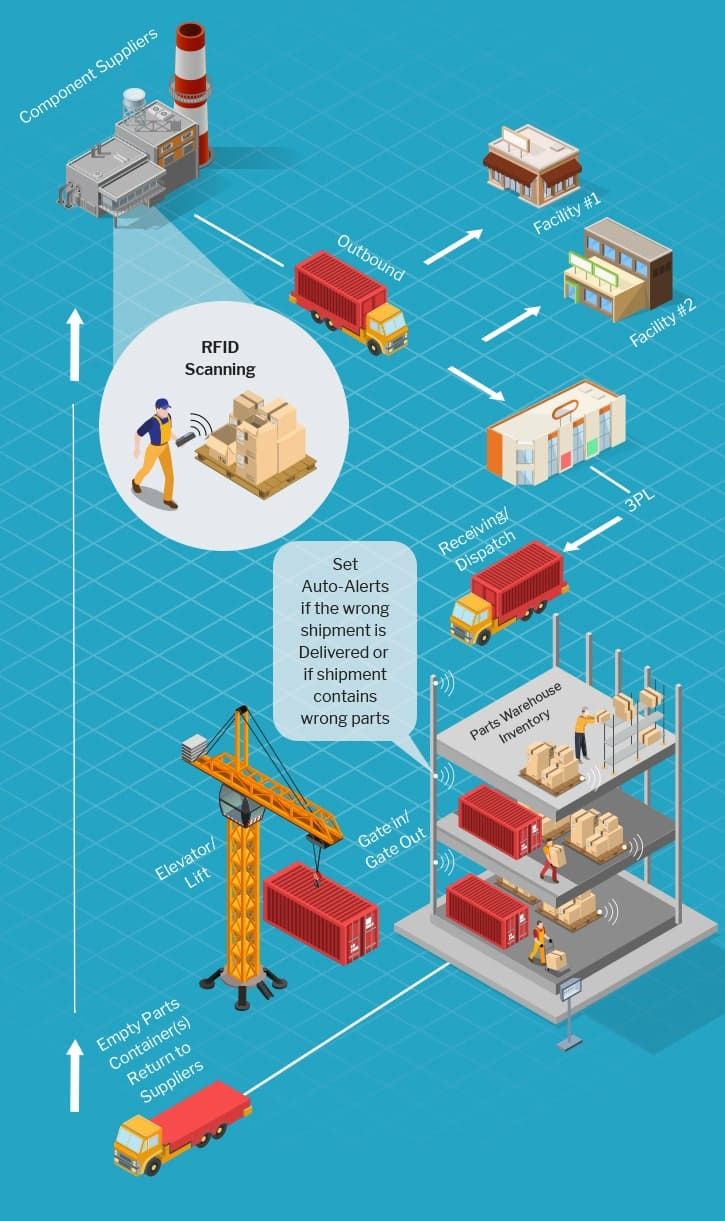We all love visiting shopping malls and supermarkets and why not? We get to buy our favorite clothes, household items, and groceries there.
Long queues at billing counters are something we've all experienced. Watching each item being scanned one at a time can feel like an endless process, especially when you're in a hurry.
Now think of a system where every item is automatically detected and processed without manual scanning. This is where RFID technology makes an impact. While many know it from retail stores, its real potential lies in supply chain and logistics where speed, accuracy, and transparency are critical.
Evolution of RFID
Do you know the products that are available in your favourite retail store go through quite a long journey? The concept of RFID is not new, its usage has been initiated at the time of the second world war. In world war 2, Britishers have used RFID to track and identify the Aircraft making system.
Mario W. Cardullo filed the first patent for modern RFID in 1970, issued in 1973. In the early 1990s, IBM engineers developed the UHF RFID system. Companies like Walmart have since invested heavily in RFID, reportedly spending around $50 million to improve tracking and visibility.
If you too wished the same then I have good news for you. RFID (radio frequency identification) is a cutting-edge technology that has made this a reality. So, let’s see what RFID is?
What is RFID?
RFID stands for “radio frequency identification”. It’s a technology that captures digital data encoded in smart labels and RFID tags through a reader via radio waves.
RFID serves a similar purpose to that of bar code or a magnetic strip of an ATM card where data from a label or RFID Bluetooth beacon tag is captured by the device and then later stored in the database.
However, RFID works better than barcode and ATM magnetic strips. The most significant advantage of using RFID over barcode is that it doesn’t need to be placed or positioned relatively to the scanner.
The other advantage is that with RFID you can scan more than one object at a time unlike barcode which saves loads of time and energy.
We have all seen the struggle that clerks go through at stores while ensuring the position of barcode, so that it can be read.

Moreover, the ATM cards also need to be swiped through a special reader.
RFID solves all these issues since it works within a few feet of the scanner. For instance, to scan a bag full of groceries, all you must do is to set the bag on the scanner without worrying about its proper positioning or placing.
Moreover, the clerk doesn’t have to scan objects one by one like in the case of a barcode.
How does it work?
RFID belongs to a group of technologies referred to as Automatic Identification and Data Capture (AIDC).
AIDC methods automatically identify objects, collect data about them, and enter those data directly into computer systems with little or no human intervention. RFID methods utilize radio waves or Bluetooth low energy systems to accomplish this.
At a simple level, RFID systems consist of three components: an RFID tag or smart label, an RFID reader, and an antenna.
RFID tags contain an integrated circuit and an antenna, which is used to transmit data to the RFID reader (also called an interrogator).
The reader then converts the radio waves to a more usable form of data. Information collected from the tags is then transferred through a communications interface to a host computer system, where the data can be stored in a database and analyzed later.
Before diving deep into the working of RFID, let’s see what are the different components that it comprises. The major part that RFID consists of are:
1. RFID tag
2. RFID reader
RFID tag
RFID tag consists of an embedded transmitter and a receiver. RFID component comprises two parts:
Integrated circuit:- It’s used for storing and processing the information.
Antenna:- It’s used to transmit and receive signals.
RFID tag also has a non-volatile memory storage which includes either programmable or fixed logic for sensor data and transmission.
Tags can be categorized as:
Passive:- This tag remains dormant since it has no battery. It uses the reader’s signal energy to turn on the tag along with reflecting a signal back to the reader that carries the real-time information.
Active:- Active RFID tags have a battery in it that transmits signals periodically. These tags have range up to 100 meters due to the presence of a battery. Due to this, active tags are useful in location tracking applications.
Battery-assistive passive:- These tags do contain a battery but it doesn’t transmit signals periodically like that of active RFID tags.
The battery is used to turn the tag when it receives a signal which enables all the energy from the reader’s signal to reflect.
RFID reader
RFID reader consists of an interrogator which is nothing but a two-way radio transmitted receiver also known as a transceiver.
The prime function of the transceiver is to transmit an encoded signal that activates the tag.
In response, the tag transponder initiates the conversion of radio signals into usable power along with responding to the reader.
How do businesses incorporate RFID into the supply chain?
Generally, the supply chain consists of four main processes which are as follows:
Integration
Better integration is a key to the success of a global supply chain. Failure in implementing a supply chain into your business is like trying to operate your business solely on technical tools instead of any kind of human effort. This doesn’t make any sense.
RFID tags allow organizations to capture data for goods in transit and share it with other supply chain partners effortlessly. That is why RFID is a worthy investment for businesses that want to expand their reach and clientele.
Operations
Daily operations impact the company’s supply chain a lot. Supply chain managers who focus on excellent day-to-day operations build a greater supply chain.
RFID scanners help companies easily monitor the movement of goods in warehouses. Inventory management becomes significantly more efficient since companies receive real-time information about warehouse activities.
Purchasing
Manufacturing the goods without raw materials is a tough nut to crack. That’s what makes purchasing essential for the supply chain process. Implementation of RFID technology into your supply chain management gives you real-time visibility over semi-finished materials and in-stock raw materials.
Apart from this, RFID also allows you to check whether everything is as per your order in the shipment, which drastically cuts down the time spent at the receiving stage and helps move items to the production stage earlier.
Distribution
Imagine that in the severe weather near your suppliers. Have they passed through the zone of danger, or do you need to come up with a contingency plan?
The word logistics means the coordination and movement of goods from one place to another.
For transport companies, it’s crucial to control quality, manage budget and achieve agreed-upon service levels. And good logistics make this possible, whether it’s the distribution of finished goods to warehouses, supplying raw materials to manufacturers, or distribution of individual items to consumers.
RFID in supply chain management and logistics
Supply chain management and logistics are considered as the most fertile field as far as the applications of RFID is concerned.
RFID in the supply chain plays a major role in enhancing the visibility right from the point of manufacturing, via supply chain, and most significantly from the back room to the floor, and ultimately to the exit door.
RFID has a major say when it comes to inventory management, warehouse management, and retail sector. Let’s see in detail about them all.

Inventory management
Inventory management is an important element of supply chain management. It includes various aspects like monitoring, administering, controlling, storing, and ultimately using the materials for the sale of a product.
Inaccuracy in inventory management is inevitable and is prevalent in many industries.
The inaccuracy is nothing but the mismatch between the inventory records and the actual amount of product available for the sale.
RFID technology can provide numerous benefits to improve the inventory management system. RFID tags have the capability to read through an item.
Moreover, the person can scan several items at a time. These properties of RFID help to speed up the inventory management process and reduce human errors thus rendering a high inventory accuracy.
Warehouse management
Warehouses are simply storage areas where you store different products received from the suppliers. These products are then distributed to the customers.
Recently, RFID has emerged as a technology that supports warehouse management system for simpler supply chain and greater product intelligibility.
With RFID technology you can automate important tasks which take place during receiving and shipping processes.
RFID also increases efficiency of identification and validation activities along with reducing human errors.
RFID ensures identification of products at an instant and greater control over items in the warehouse.
Due to this the supply chains now have a greater information flow as compared to the material flow. This further reduces currency cost.
Peerbits have developed a solution for a warehouse management system using RFID technology. Click on the below video to see how it works.
Retail sector
RFID technology has already started to revolutionize the retail sector. Wal-Mart, a behemoth in the retail sector is experimenting with the passive RFID tags of passive types to meet high consumer demand.
RFID increases the product visibility in the retail inventory that helps in better inventory control and improved customer satisfaction.
This is highly relevant in larger stores that have facilities for customers searching for their chosen products online and the store has the current stock available for sale.
Secondly, RFID provides enhanced product identification by storing distinctive identification numbers.
And at last, it reduces the checkout times since RFID enables a shopper to scan the entire content of a cart without even picking up a single item. Moreover, it helps in dynamic pricing, theft reduction, and employee tracking.
Challenges in RFID implementation
RFID is a costly affair
RFID requires costly equipment, whether it be software or hardware.
Talking about the tags, be it active, passive, or semi-passive, are a costly affair and can set the business backwards. The rates of RFID tags have lowered since the 1970s, nevertheless, many companies are reluctant to adopt them because of their steep prices.
On the other hand, many compact active RFID systems like AirFinder can make the process simpler and budget-friendly. You can place it anywhere conveniently, negating the cost of having to rework your facility.
Trouble with metals & liquids
RFID doesn’t go well with metals and liquids, as they both make it difficult to obtain proper reads on assets. In metals, the radio waves bounce all over the place. Similarly, the liquid can absorb the signals from the RFID tags.
RFID tags that can be read quickly and accurately at a distance are the winners in such. They are thin, small, waterproof, tolerate chemicals, and can manage high temperatures and rough handling.
Furthermore, its readability is not affected by metal or water. Another way to create readability is to keep a space of half or one centimetre.
Difficult to understand the technology
It’s difficult to understand the different tags and frequencies. Managers need to understand the technology well so that they can train their employees about its working.
Businesses change every single day, and so does technology. That is why you need to understand new tools that optimize performance, workflow, and communication in your employees’ daily routine.
Teach your employees to present new software. It will make them feel appreciated and pay more attention.
RFID collision course
Workers often come across reader and tag collisions. In reader collision, a worker faces interference from another reader in the field.
Similarly, in tag collision, the workers face reading an abundant amount of tags at a time. It occurs when more than one tag reflects a signal that confuses the reader.
With the constant developments in technology, certain problems have been solved up to a great extent. At the time of deploying the DRM and the new channel plan, the reader is no longer required to use the LBT.
This will increase the reading speed since the reader doesn’t have to listen to other traffic every time before transmitting.
Benefits of RFID
Asset Visibility
Have you ever imagined immediately locating misplaced things? But with RFID asset tracking technology, you can easily find your valuables that are stolen or lost. Apart from this, the RFID asset tracking solution is also important as it helps you to manage the things that you cannot see.
RFID tags can be read from any place, so that employees will immediately know the location and amount of each item. This will help them to provide the whereabouts of a shipment that has already left your facility.
Increased visibility allows supply chain businesses to resolve the issues that result from misplaced materials, faultful organisation, oversight and mistakes made during manual processes.
Reduction in labour
RFID automates the context of the supply chain to unprecedented levels, which reduces the labour throughout the process. The role of RFID technology is extremely important in the supply chain process.
It shows the value of labour in supply chains and even small reductions are considered for financial savings.
For instance, truck drivers can easily complete their weighing process by just holding their RFID tag next to the reader and get a printed ticket in return. Furthermore, RFID promises the inception of instant operator free checkouts.
Mitigate the risk of thefts
With RFID tracking devices, supply chain businesses and supply chain managers can gain faster inventory data access and location to keep the items stored, distributed, replenished or completed deliveries.
By tracking the movement of assets within your facility, you can avoid the supply chain visibility risks up to a great extent by combating theft, facilitating recalls and reducing the instances of incorrect distribution with the help of a robust supply chain risk management system.
Such mistakes need to be avoided on a priority basis because they can create legal issues, exorbitant fines or a glitch in customer service.
Technical integration
RFID functions well as a stand-alone technology, but there are emerging technologies that pair well with RFID, such as blockchain, where RFID events can act as a trigger to add a block or edge computing as RFID can create enormous data sets quickly.
Provides real-time updates
An RFID system is enabled with a real-time supply chain management system and advanced wireless networking system. As a result, you always get real-time updates about the products you have in your warehouse.
The RFID scanners and UHF RFID scanning equipment installed in the door of a warehouse can deliver instant updates of different products, critical items and individual items that come to and leave.
Worker productivity enhancement
With the introduction of RFID-enabled supply chain visibility, employee management has become easier for business owners. Because the supply chain managers do not have to waste their time on blue-collar processes such as lookout for missing equipment, searching for misplaced tools or counting stock amounts.
Sometimes it is also complicated and time-consuming to manufacture or ship a product into some scrambled facility. In this way, the manual procedures will be eradicated, the real-time visibility of the inventories will be increased, and minimizes human errors.
Real-world applications of RFID
We understood how RFID works now let’s see some of the real-world applications of RFID.
Agriculture
RFID is useful to track the movement and health of animals in the farm. It ensures that each animal in the farm is taking the correct food.
Monitoring your cattle’s health manually can be a costly affair as well time consuming.
However, with RFID you can achieve this automatically and without much expenditure.
Food Supply Chain Management
Before getting deeper into the application of RFID in food supply chain management, let us look at the meaning of food supply chain management first.
A food supply chain is a vast network of food distributors, suppliers, transporters and retailers that work together to produce healthy food products for their customers.
In today’s pandemic stricken era, the customer wants robust food transformation, supply chain transparency, and food safety assurance. And because of all these aforesaid factors, the need for improving supply chain transparency has hiked drastically which has eventually generated the need for RFID tech implementation in food supply chain management.
RFID is essential to support the e-commerce network as more and more people are ordering food online. Moreover, RFID tools are used to trace products throughout the food supply chain to gain operational capabilities.
Jewelry tracking
RFID has successfully managed to mitigate the challenge of jewelry security.
With item-level tagging of jewelry with RFID, it’s possible to track the jewelry right from the factory to the distribution center and ultimately to the store. Moreover, this process is both convenient and cost-effective.
Defense
RFID also has a key application in defense. It’s used for weapon and soldier’s movement tracking.
Moreover, it provides real-time information so it becomes easy to track down the real-time location of a weapon.
In the case of emergencies, RFID enables you to easily access the real-time data when it’s not possible to take the help of other battalions.
Laundry automation
In large companies where they have a huge number of employee uniforms, RFID can be useful in laundry management system.
It can track the uniforms that were assigned to an employee, number of times it was washed, age of uniforms, and identifies the missing uniform.
Kiosks
RFID can also be used by the kiosks for managing resources or to interact with their customers.
DVD rental kiosks use RFID tags to ensure that the customer received their chosen movie rental.
Apart from that it’s also used for interactive media display in which an RFID reader interrogates the cards or badges.
Library systems
The RFID system in the library helps in enhancing the efficiency of circulation operations. Libraries often use barcodes with proper positioning and line of sight.
Whereas, with RFID tags you scan it from multiple angles which makes the check-in and check-out process way faster than that of barcode.
We saw some of the major real-world applications of RFID technology in various sectors. But we must not forget its greatest application.
I am talking about the application of RFID in supply chain management and in logistics solutions.
Postal company
Nowadays, every business is experiencing technological evolution and postal services are no more behind in it. Postal services are using cutting edge IT systems to create, manage, classify, and report RFID events to track postal items.
A postal company’s RFID Tracking Service provides the necessary service support and management for posts using the passive RFID technology infrastructure. Apart from this RFID based real-time tracking systems help postal businesses to avoid human error or numerous shipping errors.
Conclusion
RFID technology has moved far beyond theory. From inventory tracking to warehouse automation, its role in logistics and supply chain is already reshaping operations. Throughout this blog, we explored its working, use cases, benefits, and challenges.
As adoption grows, businesses that act early will gain a clear operational edge. So, if you're planning to integrate RFID into your logistics app, now’s a good time to start.
Connect with a reliable logistics app development team that understands how to turn RFID into measurable results.









